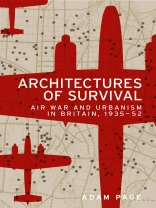Architectures of survival is an original and innovative work of history that investigates the relationship between air war and urbanism in modern Britain. It asks how the development of airpower and the targeting of cities influenced perceptions of urban spaces and visions of urban futures from the interwar period into the Cold War, highlighting the importance of war and the anticipation of war in modern urban history. Airpower created a permanent threat to cities and civilians, and this book considers how architects, planners and government officials reframed bombing as an ongoing urban problem, rather than one contingent to a particular conflict. It draws on archival material from local and national government, architectural and town planning journals and cultural texts, to demonstrate how cities were recast as targets, and planning for defence and planning for development became increasingly entangled.
Зміст
Introduction
1 In the next war: the future of cities and the future of war
2 Planning a ‘militant peace’: air raid precautions for peace and for war
3 Cities under fire: the ‘new blitz reality’
4 Seeing cities through bombsights: urban geographies of war after 1945
5 A peace that is no peace: reconstruction, defence and development in town and country
Conclusion: the ordinariness of air raids?
Index
Про автора
Adam Page is Lecturer in History at the University of Lincoln











